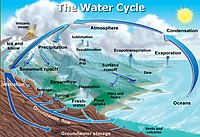
Photo from wikipedia
We reviewed studies conducted in Japan that examined the relationship between forest condition and runoff, water movement in hillslopes, and stand transpiration. The effects of forest evapotranspiration and delayed runoff… Click to show full abstract
We reviewed studies conducted in Japan that examined the relationship between forest condition and runoff, water movement in hillslopes, and stand transpiration. The effects of forest evapotranspiration and delayed runoff mechanisms by forest soil are reviewed in section II. We describe previous experimental results showing the role of preferential flow (e.g., pipe flow) and the contribution of Hortonian overland flow to subsurface water flow in hillslopes in section III. The transpiration in forest stands estimated with sap flux density measurements, which have spread rapidly in Japan, are presented in section IV. We suggest the future issues which should be solved in each section. Continuous and long-term datasets of runoff are required as the baseline reference for estimates of forest evapotranspiration and to investigate the effects of global warming on runoff processes (section II). For hillslope processes, we recognize the investigation into impacts of increases in heavy rainfall events and longer intermittent dry periods between rainfall caused by the climate change as important subjects for further investigation (section III). There is a lack of evaluation of transpiration in deciduous forests and comparisons of transpiration estimates with evapotranspiration obtained from other methods. Thus, we recommend studies to fill these gaps as well as applying sap flux density calibrations (section IV).
Journal Title: Journal of The American Helicopter Society
Year Published: 2019
Link to full text (if available)
Share on Social Media: Sign Up to like & get
recommendations!